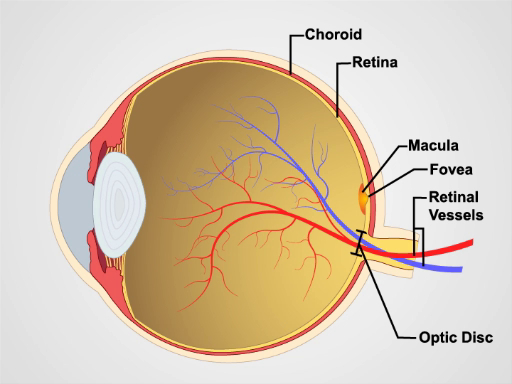眼底检查
Overview
资料来源: 公共卫生与社会医学系助理教授理查德 · 格利克曼-西蒙,MD,塔夫斯大学医学院马
最简单的眼膜曲率计包括看光阑、 屈光度指标和选择镜片的光盘。眼底镜主要用于检查眼底或内壁的眼后,组成的脉络膜、 视网膜、 黄斑、 黄斑、 视神经盘和视网膜血管(图 1)。球形眼球收集,并着重对视网膜神经上皮层细胞的光。光折射,它按顺序经过角膜、 晶状体和玻璃体。
在眼底考试期间观察到的第一个里程碑是眼睛的视神经盘,是眼睛的在哪里的视神经和视网膜血管进入后面 (图 2)。光盘通常包含中央白色生理杯,船只在其中输入;它通常占据整个光盘少于一半的直径。只是横向和稍逊是凹,暗调的圆形区域,划定中央视力的点。周围是黄斑。世俗的目光线的盲点大约 15 ° 结果从感光细胞在视神经盘缺乏。

图 1。眼睛的解剖。图人眼的矢状面观与标记的结构。

图 2: 正常视网膜。一张照片显示正常视网膜眼底观。
Procedure
因为散瞳眼药水通常是不使用一般实践,眼底的视图仅限于只后视网膜的一段。在尝试检查病人之前很熟悉这些功能。
- 除非病人的屈光不正,因此难以聚焦在视网膜上,它是通常最好删除你自己镜片为这次考试。
- 后变暗的房间,打开检眼镜,光芒在你的手上或在墙上。
- 转动镜头光盘,直到可以看到光的大白圈,和意义检眼镜镜片屈光度指标读取 0,既不会聚也不分散的光。
- 保持你的食指镜头光盘上考试期间,所以可调整屈光度必要把焦点集中在视网膜的组织结构。
- 要检查病人的右眼,在你的右手举行检眼镜和通过与你的右眼; 光圈看考试到病人的左眼,抱在你的左手和看通过孔径与你的左眼眼底镜。这样可以避免碰撞与病人的鼻子。
- 约有一英尺从病人眼一级确定自己的位置和要求患者只是在你肩上盯着墙上的一个点。
- 如你同行通过孔径,睁大双眼打开牢固地靠在你的眼眶,眼底镜,按住手柄轻微的角度,从患者的脸。
- 关于病人的线的视觉 15 ° 外侧检眼镜的位置。直接到瞳孔光和寻找橘红色的光晕。这是红色的反射。请注意任何不透明,似乎能干扰。
- 专注于红的反射,和移动向内沿
Application and Summary
跳至...
此集合中的视频:

Now Playing
眼底检查
Physical Examinations II
66.9K Views

眼科检查
Physical Examinations II
76.1K Views

耳朵考试
Physical Examinations II
54.0K Views

鼻子、 鼻窦、 口腔和咽部考试
Physical Examinations II
64.9K Views

甲状腺考试
Physical Examinations II
103.8K Views

淋巴结考试
Physical Examinations II
382.9K Views

腹部考试 i: 检查和听诊
Physical Examinations II
201.1K Views

腹部考试 II: 打击乐
Physical Examinations II
246.3K Views

腹部考试 III: 触诊
Physical Examinations II
137.8K Views

腹部考试四: 急性腹痛评估
Physical Examinations II
66.7K Views

男性直肠检查
Physical Examinations II
113.2K Views

全面的乳房检查
Physical Examinations II
86.0K Views

外生殖器的盆腔检查 i: 评估
Physical Examinations II
301.6K Views

骨盆 II: 窥镜考试成绩
Physical Examinations II
148.8K Views

盆腔检查三: 双手和直肠阴道考试
Physical Examinations II
146.0K Views
版权所属 © 2025 MyJoVE 公司版权所有,本公司不涉及任何医疗业务和医疗服务。